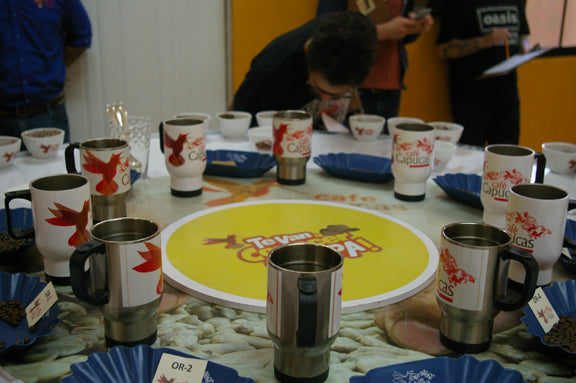The Q Grader course was six days long. I cupped at least 240 cups of coffee throughout the week.
The course tests your sensory skills, primarily olfactory and taste. One of the hardest tests was identifying sweet, sour, salty, the combination of tastes, and the concentration of each. That was one of my weakest tests. I am so glad I passed because I did not want to take it again.
Another section was olfactory: identifying vials of aromas. Le Nez du Café prepares the aromatic vials that contain the aromas most often found in the world’s top coffees. You need to train your olfactory senses to identify these smells. They can be enzymatic, like fruits and florals. They can be in the ‘sugar browning’ category, like chocolate, caramel, vanilla and roasted nuts. They can be in the ‘dry distillation’ category, like pine, tar, black currant. They can be considered ‘taint’ smells, like beef, rubber, smoke, leather. Each of the smells correlates to the coffee flavor wheel.
The Triangulation section of the test gives you three cups of coffee, two are the same and one is different. You have to identify the different one. It’s not just one set, though. There are six flights of three coffees. The coffees are predominantly identified by their aromatics but astringency and acidity in taste do come into play at different temperatures.
The Matching Pairs section of the test gives you six flights of four coffees. You have to identify which cups had acid and which acid it was. There are six acids that can be present in coffee: citric or lemony; malic, sort of like green apple; lactic, which is body; quinic or bitter; phosphoric, which is iron-y, or non-ogranic; and acetic or vinegar. It was easy to identify which cups had the acids, but it was much harder to identify the name of the acid. Again, this was a difficult test and one I was very pleased not to have to retake.
The next test was the Roast Sample ID. In this one, you’re assessing the roast of the coffee. If a coffee is not roasted right, you can’t properly assess the green coffee. You need to determine, has the roast protocol been followed? Otherwise, your assessment of the coffee will be skewed.
The Green Grading section was about identifying and grading defects in coffee. Defects can include insect damage; black bean; improperly picked beans; sticks or stones; cherry pod; beetle borer; chipped or broken beans; immature beans; withered beans, which are too old; shells, floaters; hulls or husks. Any of these things will lead to off colors or flavors in the coffee.
The Roast Grading section of the test included cupping coffees roasted improperly. If the coffee is not roasted within the guidelines, it is impossible to properly evaluate them.
The most fun and most intense section of the test was the cupping. We evaluated coffees from four different cupping tests: Central/South American milds; naturals; Indonesian; and, East African. There were six flights of coffee, five unique and one repeated. Each flight had five cups to check uniformity. It was a peer grading format, so we had to be calibrated with each other and the Q instructor.
The Q-Grader course and testing was one of the most intense things I have done because you have to be so focused on everything. When the coffee is hot, you look for flavor and aftertaste. As it cools, you test for body. When it’s at room temperature, you make a second assessment of everything and ask, did the quality maintain?
You can’t let your mind wander for a moment. You’re assessing, processing, note-taking and referencing the entire time. To taste 30 cups of coffee at three different temperature ranges, you have to be mentally present in every moment. You get tired mentally. Your senses get overwhelmed. Your olfactory and taste senses get tired. It’s intense. By the time it ended, I was just exhausted, emotionally and physically. It’s a marathon once you start the testing component. To be present in every moment takes a lot of energy.
The Q is the international standard by which coffee is measured. You’re not supposed to have any preconceived notions about a coffee. Using the index of all the coffees you’ve tasted, you’re able to put concrete values on the coffee.
As a coffee professional, is the Q license valuable? It depends on your career goals. At the time, it was valuable for me to establish a reputation for coffee acumen. Plus, it certainly boosted my confidence. I use the Q skills everyday, so in the end, yes, it was worth it.
~ Emeran


